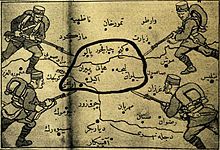This article may require cleanup to meet Wikipedia's quality standards. The specific problem is: Text contains incorrect grammar that could be translated text. (October 2022) |
| Sheikh Said rebellion | |||||||
|---|---|---|---|---|---|---|---|
| Part of Kurdish rebellions in Turkey | |||||||
 Turkish soldiers encircling Palu, Çapakçur (present-day: Bingöl), Genc (present-day: Kaleköy, Solhan), Piran, Hani, Lice, Ergani, Egil and Silvan, Cumhuriyet Newspaper, 30 March 1925. | |||||||
| |||||||
| Belligerents | |||||||
|
|
| ||||||
| Commanders and leaders | |||||||
|
|
| ||||||
| Strength | |||||||
|
February–March: 25,000 men (fewer than 12,000 are armed troops; the rest are unarmed logistical troops)[1] April: 52,000 men (25,000 are armed troops)[1] | 15,000 men[1] | ||||||
| Casualties and losses | |||||||
| Total: 15,000–20,000 killed[2] | |||||||
The Sheikh Said rebellion (Kurdish: Serhildana Şêx Seîd,[5] Turkish: Şeyh Said İsyanı) was a Kurdish nationalist rebellion in Turkish Kurdistan in 1925 led by Sheikh Said and with support of the Azadî[6] against the newly-founded Turkish Republic.[7] The rebellion was mostly led by Zaza speakers, but also gained support among some of the neighboring Kurmanji-speaking Kurds in the region.[8]
The religious and nationalist background of the Sheikh Said rebellion has been debated by the scholars.[9] The rebellion was described as "the first large-scale nationalist rebellion by the Kurds" by Robert W. Olson.[10]
- ^ a b c d Olson 1989, p. 107.
- ^ The Militant Kurds: A Dual Strategy for Freedom, Vera Eccarius-Kelly, page 86, 2010
- ^ Martin van Bruinessen, "Zaza, Alevi and Dersimi as Deliberately Embraced Ethnic Identities" in '"Aslını İnkar Eden Haramzadedir!" The Debate on the Ethnic Identity of The Kurdish Alevis' in Krisztina Kehl-Bodrogi, Barbara Kellner-Heinkele, Anke Otter-Beaujean, Syncretistic Religious Communities in the Near East: Collected Papers of the International Symposium "Alevism in Turkey and Comparable Sycretistic Religious Communities in the Near East in the Past and Present" Berlin, 14-17 April 1995, BRILL, 1997, ISBN 9789004108615, p. 13.
- ^ Martin van Bruinessen, "Zaza, Alevi and Dersimi as Deliberately Embraced Ethnic Identities" in '"Aslını İnkar Eden Haramzadedir!" The Debate on the Ethnic Identity of The Kurdish Alevis', p. 14.
- ^ Zülküf, Ergün (2015). "Gotara Dijkolonyal û Wêneyê Serdestiya Tirkan Di Kovara Hawarê De" (PDF). Monograf (in Kurdish) (3). Artuklu University: 400–437.
- ^ Olson 1989, p. 42.
- ^ Hassan, Mona (10 January 2017). Longing for the Lost Caliphate: A Transregional History. Princeton University Press. ISBN 978-1-4008-8371-4.
- ^ Mehmed S. Kaya (15 June 2011). The Zaza Kurds of Turkey: A Middle Eastern Minority in a Globalised Society. I.B.Tauris. pp. 64–. ISBN 978-1-84511-875-4.
was led specifically by the Zaza population and received almost full support in the entire Zaza region and some of the neighbouring Kurmanji-dominated regions
- ^ Özoğlu, Hakan (2009). "Exaggerating and exploiting the Sheikh Said Rebellion of 1925 for political gains". New Perspectives on Turkey. 41: 181–210. doi:10.1017/s0896634600005410. ISSN 0896-6346. S2CID 152152964.
- ^ Olson 1989, p. 153.